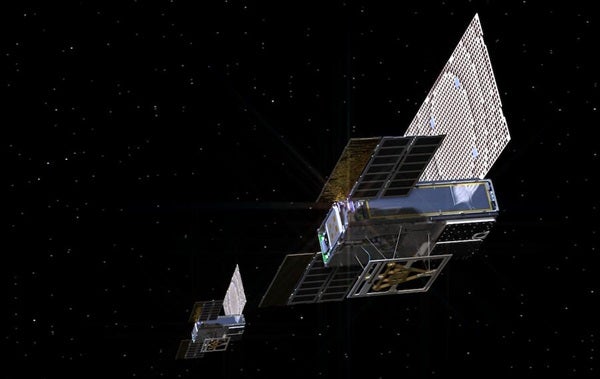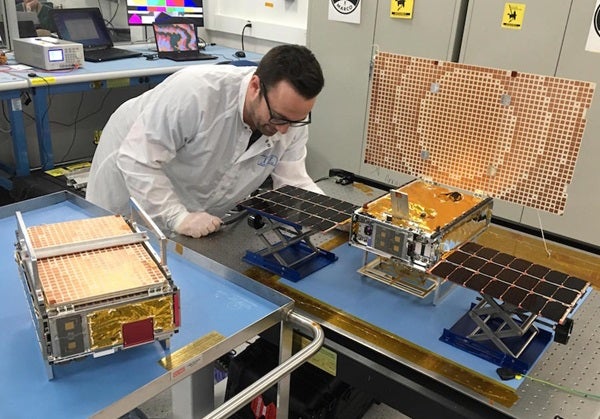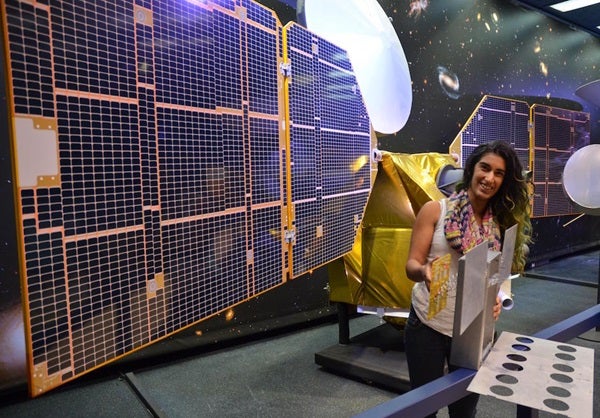CubeSats are a small and relatively inexpensive type of spacecraft, and they tend to use off-the shelf technologies. In recent years, dozens of them have been launched into low-Earth orbit by scientists, students, and businesses alike. The MarCOs, however, are the first CubeSats to travel into deep space, and they could pave the way for a new generation of small spacecraft that would make doing interplanetary space science much more accessible.
Interplanetary test subjects
The Mars Cube One (MarCO) satellites themselves are mostly flying to test the technologies that could take CubeSats beyond Earth orbit. Bruce Banerdt, a research scientist at NASA’s Jet Propulsion Laboratory and InSight’s principal investigator, calls them “an interesting and cool piggyback to our mission,” but notes that they won’t affect the core science that InSight will perform. If the MarCOs make it to Mars, they will relay communications from InSight as it lands in real time, but what really matters is the knowledge they’ll provide on what it takes to send small spacecraft on interplanetary missions.
There are already teams working on concepts and designs for future CubeSats and small spacecraft that will go on interplanetary missions, and they’re watching how well the MarCOs survive heat and radiation, how successfully they can communicate, and how well they deal with the propulsion and navigation challenges of their mission.
Kunio Sayanagi, an assistant professor at Hampton University, is working on a concept for a small spacecraft that would take atmospheric measurements of Uranus or Neptune. “If [the MarCOs] can get there at all, it’s going to be a huge deal,” he says. If they do, however, he’s likely to incorporate the most reliable features of the MarCOs into his own designs.
“I’m a scientist trying to take data,” Sayanagi says. “Where I am in my position is to look for engineering systems that work to allow scientific measurements I want to take.” He adds, “Everyone’s afraid of using something for the first time.” By including the MarCOs with the InSight launch, Sayanagi says, NASA is testing these technologies for the rest of the community with very little added cost.
The challenges of deep space
The MarCOs will face many challenges between Earth and Mars. “Deep space is a very unforgiving environment,” says Joel Steinkraus, MarCO lead mechanical engineer at JPL. The success CubeSats have had in Earth orbit often can’t be replicated directly in deep space, he explains.
Then there are the extreme conditions in deep space. Steinkraus says, “We designed a single outfit so MarCO could run a marathon in the Sahara while snowshoeing in the Arctic at the same time,” referring to the vast temperature variations that the spacecraft will encounter. Aside from heat and cold, deep space has a different radiation environment than is found in Earth orbit. Steinkraus notes that high-energy particles can easily flip bits and affect transistors, so the CubeSats’ systems need to understand and detect faults when they occur.
Deep space will also test the MarCOs’ ability to propel and orient themselves. About half of each MarCO spacecraft consists of a propulsion system, Steinkraus says. The CubeSats are stocked with compressed R236FA gas, a propellant commonly used by fire extinguishers. However, they won’t have the same navigation tools available to CubeSats in Earth orbit. Without GPS or a nearby planetary body, they’ll rely on tracking the positions of the stars and the Sun to know exactly where they are and where they are going.
Finally, powering all these functions takes a lot of energy as well. Steinkraus explains that the farther the MarCOs get from the Sun, the less energy their solar arrays will be able to collect. The CubeSats are designed to subsist on a “low-calorie diet of photons,” storing excess energy along the way so there will be enough juice on hand when it’s time to relay data from Mars to Earth.
Dreams for the future
Even if the MarCOs prove that CubeSats can function beyond Earth orbit, they’re not likely to replace larger spacecraft. “CubeSats are very good at performing very specific tasks and being very focused,” says Steinkraus. However, they are much too limited to handle complex missions on their own.
Nonetheless, Sayanagi sees potential in small spacecraft that detach from larger missions to gather additional measurements that would otherwise be impossible. For example, his concept calls for a small probe to dive into the atmosphere of an outer planet, without requiring the larger spacecraft that carried it there to do the same. Sayanagi thinks it’s unlikely that a CubeSat could make it to an outer planet on its own anytime in the near future. If small spacecraft hitch rides with larger spacecraft, however, the communication and power challenges involved go “from the impossible to the possible,” he says.
When they can fly solo, CubeSats and other small satellites could have a major impact on space science by filling in key gaps in data. For example, Valeria Cottini, an associate research scientist at the University of Maryland and principal investigator for the CubeSat UV Experiment, is working on a mission concept for a CubeSat that would travel to Venus to investigate its atmosphere. For decades, planetary scientists have wrestled with questions about mysterious stripes that appear in Venus’s cloud layer when viewed in ultraviolet. Waiting for the next big mission to Venus could mean going without new data for 10 years or more. But Cottini’s CubeSat concept would provide a relatively cheap and feasible way to fill in information on the venusian cloud tops. In general, she says, CubeSats could be complementary to larger missions and enable science that would otherwise be impossible due to time, money, or risk constraints.
“One of the holy grail things about a [CubeSat] is taking advantage of launching multiple units,” says JaeSub Hong, an instrument scientist and Harvard astronomer. Hong is deputy principal investigator for CubeX, a mission concept that would use a small spacecraft equipped with an X-ray telescope to scan exposed material in impact craters on the Moon. Measuring the elemental composition of these deep-seated materials could help scientists better understand the evolution and early history of the Moon. A small spacecraft may not be able to scan the complete surface of the Moon, but Hong points out that making a second or third after building the first one would be relatively easy. “It could be possible to extend, expand, or enhance the mission in a gradual fashion,” he says.
Hong notes that, while such a spacecraft could theoretically investigate asteroids and other airless bodies, the team decided to first aim for the more achievable goal of going to the Moon. “I thought going to the Moon would be easy by now, but it isn’t,” Hong says. “It may be easier than other distant targets, but it’s still very hard.”
However, despite the challenges, some of the next CubeSats to go beyond Earth orbit will be headed for the Moon. The Exploration Mission 1 (EM-1) — which is the first launch scheduled for NASA’s new Space Launch System in 2020 — will carry 13 CubeSats, including several built by student and amateur teams.
After all, as the saying goes: Good things come in small packages.













